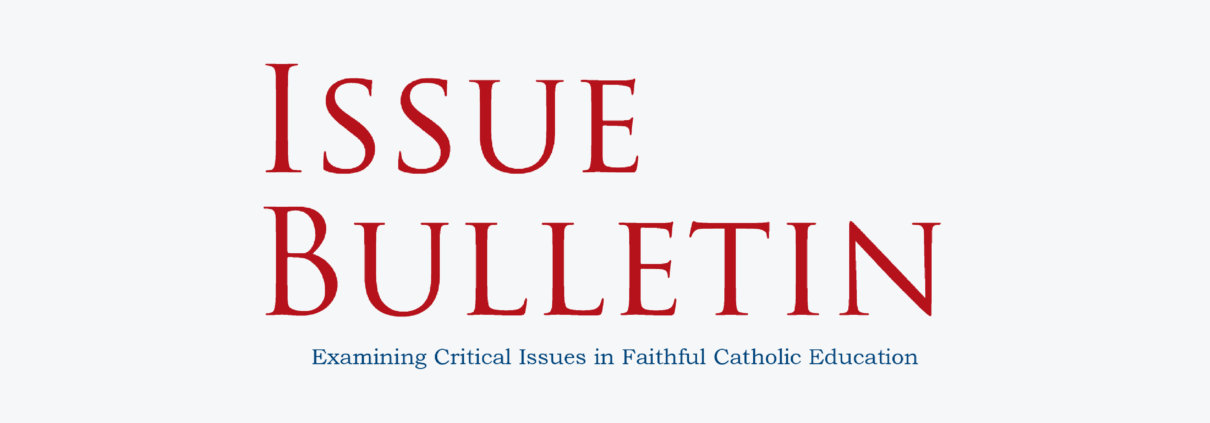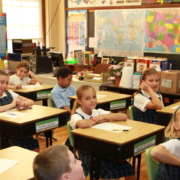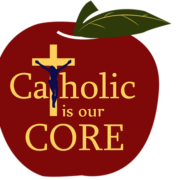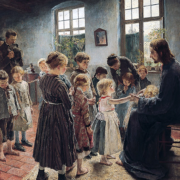Many Diocesan and Private Catholic Schools Find Success Outside of Common Core
This publication is part of a series of reports on the Common Core State Standards Initiative and how those standards potentially impact Catholic education.
At least 33 Catholic dioceses and scores of private and independent Catholic schools across the United States have decided to take a cautious approach to the relatively new and untested “Common Core” and have opted out of using it so far. They have continued to use their own standards and curricula that have kept them at the top of the academic charts for decades. Their courage and conviction in not following the latest educational reform and sticking to what has been field-tested and fully vetted is worthy of review. Here’s a brief overview of what some of these dioceses and schools have done.
The Archdiocese of Denver was among the first to acknowledge concerns and withhold acceptance of the Common Core State Standards (CCSS). Denver was soon followed by the Diocese of Fargo and then the Dioceses of Pittsburgh, Manchester, Lansing, Madison, and Superior. Each of these confident and high-performing dioceses issued formal statements justifying their decisions not to jump on the Common Core bandwagon. Many published statements by the bishop or superintendent.
In some cases, statements came after thoughtful and heartfelt input from parents and from concerned faithful Catholics who had grave concerns about bringing the Common Core standards into Catholic schools. The parents’ concerns included a worry about a decline of Catholic identity; that the strict college and career focus of the utilitarian standards did not properly focus on the integral development of students; that the standards were in places less rigorous, slowed math progression and reduced exposure to great literature; that the standards were untested; and that the standards were thrust upon the nation without full disclosure about their impact and even their content. One of the earliest and most insightful groups of parents was Pittsburgh Catholics Against Common Core, who appealed to Bishop David Zubik to rely on the Diocese of Pittsburgh’s more complete Catholic standards. Bishop Zubik, after careful consideration, later issued a statement assuring that only fully Catholic resource materials would be used in the schools and participation in any federal student data sharing would not occur.
Other dioceses have followed with similar policies, since the Common Core standards starting manifesting themselves in Catholic schools in 2012. The Diocese of Baker, Oregon, is among the most recent to reject the full implementation of the math and English language arts standards, stating earlier this spring, “there are more than a few reasons to be cautious about adopting Common Core.” These include the lack of endorsement by some English and math professors present on the original validation committee and concerns about potential content issues with history, health education and social studies.
Other dioceses not using the CCSS include Little Rock, Nashville, and Wilmington. They have elected to continue the use of their own diocesan designed standards and curriculum guides. These tested and successful guides not only include specific standards but also resource material, formal and informal assessments, instructional approaches, student accommodations and suggestions for parental involvement. Many of the standards, while self-selected, take into account some secular and professional standards and incorporate them into the diocesan designed program of study; the dioceses do not operate in a complete vacuum, although they do operate with a distinctly Catholic paradigm.
While it is uncertain from their websites whether other dioceses in Texas use the CCSS, the Diocese of Galveston-Houston and the Diocese of Dallas indicate that they use their own internally designed curriculum guides based on the National Council of Teachers of Mathematics (NCTM), the National Council of Teachers of English (NCTE), the Texas Essential Knowledge and Skills (TEKS), the Iowa Test of Basic Skills (ITBS) and the International Reading Association (IRA). The Diocese of Austin bases its standards on the TEKS. These three dioceses educate 39,462 school children or 51 percent of the total Catholic student population taught in Texas (McDonald & Schultz, 2015).
Adjacent to Texas, the Dioceses of Tulsa and Oklahoma City use their own internal, previously generated curriculum guides and make no reference to the use of Common Core standards. Similarly, the dioceses in Nebraska and Virginia, whose state school officers never elected to incorporate the standards, do not use the Common Core. The dioceses in these four cities and states add another 63,953 Catholic school children being educated without Common Core (McDonald & Schultz, 2015).
At least seven of these non-Common Core dioceses have their curricula online: Charleston, Dallas, Denver, Galveston-Houston, Nashville, Superior and Tulsa. Some dioceses have offices for curriculum and instruction and are able to work on these areas full-time. These dioceses use the existing professional, state and national standards along with the professional expertise of curriculum designers, members of the clergy, religious orders and input from teachers to create guides or standards for their school systems.
One problem faced by these non-adopting dioceses is how to steer clear of both the Common Core standards and the instructional approaches the standards employ, when using textbooks and materials created by publishers whose goods are stamped “Common Core aligned”. This has raised, and continues to raise, concerns among parents who see these books and worksheets coming home after having been told Common Core standards are not utilized in their diocese.
Sandra Leatherwood, director of Catholic education for the Diocese of Charleston, addresses this issue by saying that although it’s awfully hard to get around the use of Common Core- marketed materials, schools don’t have to teach the Common Core Standards when they use these books. They can use their own created curriculum guides. Like most dioceses that work under the concept of subsidiarity, in the Diocese of Charleston, representative teachers from each school gather first to develop the math and English standards and then bring them back to the individual schools for internal review and comment. In her Diocese, Leatherwood said the local teachers have the autonomy to select the textbooks that best align to their own created curriculum. Leatherwood emphatically stated that the issue is not whether the textbook is aligned to Common Core, but whether the textbook aligns to the diocesan curriculum.
A number of Catholic schools and dioceses have come to see that choosing the best materials and using the best instructional methods means not incorporating all of the instructional “shifts” required by the Common Core standards, such as reducing selections of classical literature or implementing a recreation of the 1990s “Math Wars”.. These schools and dioceses require instructional approaches that promote rigor and perseverance by forcing students to think for extended periods of time, pushing their developmental capacity. Reducing classical selections that portray man in all the scenarios of his perpetual struggle to survive and buying literature anthologies that look like commercials are something these dioceses and private independent schools have chosen not to do. Rather they focus on the use of proven pedagogy and proven curricula that facilitate the search for authentic and transparent truth, whether inside or outside the specific text that children encounter.
Most of the dioceses that have not implemented the Common Core emphasize on their websites and official statements the desire to prepare students for more than college and career. These dioceses have taken to heart the U.S. Conference of Catholic Bishops clarification that the Common Core standards are “insufficient” to guide Catholic education. These dioceses are upfront that the purpose of their schools is to educate the whole child in a unique Catholic worldview, where educational accomplishments sit alongside other milestones of life. They emphasize that their educational efforts are ordered toward the fulfillment of the whole person, and they do not view knowledge as primarily a commodity to be bought, sold and amassed for worldly success.
A Catholic school’s primary concern is not that students measure up to the standards of the world so that they can compete in the race for economic security and academic stature. Rather, Catholic schools fulfill an evangelizing mission of providing opportunities for their students to encounter Christ in a personal and intimate way. Instilling virtue, integral formation and development of the soul and pursuing authentic truth in a culture of relativism are all central to a Catholic school’s standards and curriculum. Catholic schools are much more than the Common Core.
Acknowledging this, and the fact that the vast majority of schools in the nation are singing from one sheet of music and following one “way” of going about the complex human activity that is education, some dioceses have gone a little further and are exploring a liberal arts/ classical curriculum model using original source documents and a structured developmental pedagogy. And both the Diocese of Marquette and the Kaukauna Catholic School System in the Diocese of Green Bay, Wisconsin, have decided to move toward the integration of English Language Arts and Social Studies into a combined Humanities program.
As with the best Catholic schools in the country, faith permeates the curriculum in these schools, but curriculum is framed around the historical development of Christianity and the developmental aptitudes of the child. These schools are more concerned with process and excellence of content, rather than standards. They are more concerned with setting a child’s imagination and creativity on fire, rather than unending mind-numbing assessments designed to quantify and measure learning so as to weed out bad schools and teachers. Their classical, liberal-arts model emphasizes the use of inspired learning and authentic teacher-based assessment of student (not teacher or school) progress. Individualized attention, focus on tried and true stories emphasizing what is noble and normative of human excellence, happiness and flourishing, these schools are places of joy and intense academic growth.
There are many examples of individual schools seeking to break out of the cookie-cutter Common Core curricula and reclaim their rich heritage—and in the process, reclaim their market share. Families stuck in Common Core schools are looking for something unique, something uncommon, something that will help their child stand out in a crowd, and more importantly help their child love school and love to learn for learning’s sake. Near-failing Catholic schools such as St. Jerome’s in Maryland have seen dramatic turnarounds by boldly proclaiming a Catholic and classical identity. Other schools formerly on the brink of closure such as St. John the Baptist Parish School in Ottsville, Penn., are seeking to follow suit and fight their way to prominence by being boldly Catholic and boldly counter-Common Core.
It’s not only existing Catholic schools that are recovering a sense of education that is beyond college and career; new schools are starting up to meet the need for something more than the Common Core. The National Association of Private Catholic Independent Schools has seen a dramatic increase in membership since the Common Core started gaining a foothold in 2012. New private schools teaching the Catholic faith have sprung up in Arizona, the District of Columbia, Illinois, Minnesota, Missouri, South Carolina and Wisconsin. Many of these schools are using a classical pedagogy and courses of study from foundational homeschool programs such as Kolbe Academy, Mother of Divine Grace and the new Chesterton Academies. It is undetermined how many students these recognized members plus autonomous up-starts are teaching, but theirs is an upward trend (Donohue, 2014). A newly formed support organization called The Institute for Catholic Liberal Education has also seen rapid growth in the last two years, as it seeks to expose a hungry market to a comprehensive approach to education which is wholesome, weighty, meaningful, tested and soul-nourishing.
In time, there may be some fruits that come from the Common Core, but there is already plenty of good fruit on the table of classical and faith based-liberal arts schools. The children are happy and well-fed. Room for more fruit, once ripe and deemed healthful, can perhaps be made in the future with care. Until then, there is much to feast upon while we wait—and waiting is something we Catholics do well.
References
Donohue, D. (2014). Private independent Catholic schools: Components of successful start-up schools. Accessible at http://gradworks.umi.com/35/81/3581846.html.
McDonald, D. & Schultz, M. (2015). The annual statistical report on schools, enrollment and staffing: United States Catholic elementary and secondary schools 2014-2015. (Arlington, VA: National Catholic Educational Association).



 St. Agnes School, St. Paul, MN
St. Agnes School, St. Paul, MN 


